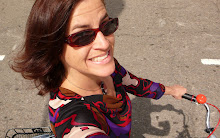
"Why fractals?" you might ask. Because I saw a performance piece by Kathleen Hermesdorf at ODC with my artistic partner in crime Jessica on Sunday night that began with an analysis of fractals--what they mean, what they symbolize, how they are represented in nature. I became increasingly curious about fractals, that they can resemble so many things that are dissimilar (a cloud, a mountain range, a fern). I began to wonder what else is a fractal? My body? My life? Our lives? My relationships? My art? My cat? My niece? My stolen keys? My duplicate keys? San Francisco? Paris? My short story? My career? My memory? My imagination? The film I'm making with Jessica? The hard drive that is dead and in the process of being resurrected?
Here is a definition from dictionary.com:
frac·tal [frak-tl]
–noun Mathematics, Physics. a geometrical or physical structure having an irregular or fragmented shape at all scales of measurement between a greatest and smallest scale such that certain mathematical or physical properties of the structure, as the perimeter of a curve or the flow rate in a porous medium, behave as if the dimensions of the structure (fractal dimensions) are greater than the spatial dimensions.
And from Benoit Mandelbrot, who coined term while mapping the English coastline:
1975, from Fr., from L. fractus "broken," pp. of frangere "to break" (see fraction).
"Many important spatial patterns of Nature are either irregular or fragmented to such an extreme degree that ... classical geometry ... is hardly of any help in describing their form. ... I hope to show that it is possible in many cases to remedy this absence of geometric representation by using a family of shapes I propose to call fractals -- or fractal sets." [Mandelbrot, "Fractals," 1977]
And a description of fractals in nature from Wikipedia:
Fractals in nature
Approximate fractals are easily found in nature. These objects display self-similar structure over an extended, but finite, scale range. Examples include clouds, snow flakes, crystals, mountain ranges, lightning, river networks, cauliflower or broccoli, and systems of blood vessels and pulmonary vessels.
Trees and ferns are fractal in nature and can be modeled on a computer by using a recursive algorithm. This recursive nature is obvious in these examples — a branch from a tree or a frond from a fern is a miniature replica of the whole: not identical, but similar in nature.


No comments:
Post a Comment